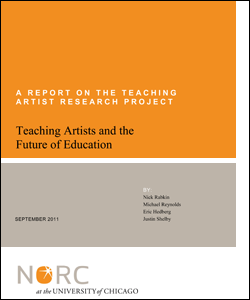Teaching Artists and the Future of Education
A report on the Teaching Artist Research Project
September 2011, 288 pages. NORC, University of Chicago, 55 E. Monroe Street, Chicago, IL, 60603, (312) 759-4000, www.norc.org.
Download:
![]() Teaching Artists and the Future of Education (3.14Mb)
Teaching Artists and the Future of Education (3.14Mb)
Teaching artists—artists who make teaching a part of their professional practice as artists—are critical to the future of arts education and to improving the quality of schools. These are two of the conclusions in this final report of the Teaching Artists Research Project, a three-year study by NORC at the University of Chicago that is the most comprehensive examination of the work and world of teaching artists.
Teaching artists have been major providers of arts education in community settings for over a century. In the last three decades they have become important resources in primary and secondary schools as well, where they have mitigated a long-term decline in arts education. In the process they have made significant contributions to making schools better places for students to learn and grow.
Prior studies have provided strong evidence that arts education has powerful positive effects on student achievement and outcomes. NORC’s new study offers hope to schools struggling to preserve arts education programs and to policy-makers searching for effective education strategies to improve schools.
“Careful analysis of student data and evaluation of arts education programs has shown that learning in the arts is strongly correlated with improved student behavior, attendance, engagement in school, critical thinking, problem solving, creativity, social development, and, yes, even test scores,” said Nick Rabkin, principal investigator for the study. “The positive effects are most significant for low-income students. Given the data, art education should not be a perpetual candidate for funding cuts, but a core element of education reform.”
The NORC study found that teaching artists are an underutilized resource. They are abundant in larger cities with well-developed arts institutions and communities, but they are present in smaller communities as well, even rural communities. Most work part-time, earning about $10,000 a year from their teaching, and are eager for more work. They can be an important element of any strategy to reverse the long-term decline in arts education for American children and serious assets to schools intent on becoming more creative places for children to learn.

